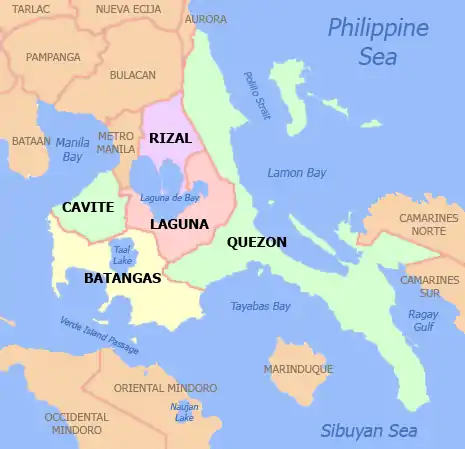Indang
Indang, officially the Municipality of Indang (Tagalog: Bayan ng Indang), is a 1st class municipality in the province of Cavite, Philippines. According to the 2015 census, it has a population of 65,599 people. [4]
Indang | |
|---|---|
| Municipality of Indang | |
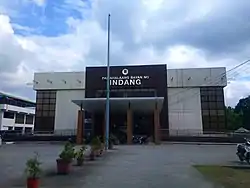 The new Municipal Hall | |
 Seal | |
Nickname(s):
| |
| Motto(s): Indang Atin 'to! [1] | |
 Map of Cavite with Indang highlighted | |
OpenStreetMap 
| |
.svg.png.webp) Indang Location within the Philippines | |
| Coordinates: 14°12′N 120°53′E | |
| Country | |
| Region | Calabarzon (Region IV-A) |
| Province | Cavite |
| District | 7th District |
| Founded | 1655 |
| Barangays | 36 (see Barangays) |
| Government | |
| • Type | Sangguniang Bayan |
| • Mayor | Perfecto V. Fidel |
| • Vice Mayor | Ismael D. Rodil |
| • Representative | Jesus Crispin C. Remulla |
| • Electorate | 46,884 voters (2019) |
| Area | |
| • Total | 74.90 km2 (28.92 sq mi) |
| Elevation | 325 m (1,066 ft) |
| Highest elevation | 380 m (1,250 ft) |
| Population | |
| • Total | 65,599 |
| • Density | 880/km2 (2,300/sq mi) |
| • Households | 14,797 |
| Demonym(s) | Indangeño, Taga-Indang |
| Economy | |
| • Income class | 1st municipal income class |
| • Poverty incidence | 5.52% (2015)[5] |
| • Revenue | ₱155,850,630.21 (2016) |
| Time zone | UTC+8 (PST) |
| ZIP code | 4122 |
| PSGC | |
| IDD : area code | +63 (0)46 |
| Climate type | tropical monsoon climate |
| Native languages | Tagalog |
| Major religions |
|
| Feast date | September 3 |
| Catholic diocese | Diocese of Imus |
| Patron saint | Saint Gregory the Great |
| Website | www |
The municipality is situated in the central part of Cavite Province approximately 12 kilometers (7.5 mi) from Tagaytay Ridge. The Municipality consists of the Poblacion and surrounding barangays with a total land area of 8,920 hectares (22,000 acres).
Etymology
Indang (originally called Indan) was established as a town in 1655, when it was administratively separated from the nearby town of Silang, Cavite. Indang derived its name from the words "Inrang" or "yndan", a tree which was also called "Anubing". The tree of Inrang was used to be abundant in the local since the early times.[6][7]
History
Before 1655: Separation and Independence
Indang was part of Silang, Cavite for about 70 years, the municipality of Indang was organised with a prominent native, Juan Dimabiling, as the first gobernadorcillo. The distance between the barrio of Indang and the poblacion of Silang caused the residents of the former great difficulty in transacting officials business and attending religious services. This led the people of Indang to petition higher authorities for the conversion of the barrio into a separate municipality. The exact month and day of the municipality’s establishment has no verification. However, existing documents proved that Indang was instituted during the cold month of 1655. Therefore, the municipal government decided and declared December 1 as "Indang Day" which was annually celebrated and thereafter by its people.[6][8]
1896-1897: The Philippine Revolution
During the Philippine Revolution, Indan was known by its Katipunan name "Walang Tinag". It was also during this time that the letter "g" was added to its name; thus it is now called Indang. It belongs to the Magdiwang faction, which rivaled the Magdalo faction headed by Emilio Aguinaldo. In Barangay Limbon, Andrés Bonifacio was arrested after being defeated in the Tejeros Convention and prevented from pursuing his counter-revolutionary plan according to witnesses. One of these witness was Severino de las Alas, a resident of the town, who accused Bonifacio of trying to burn the Church of Indang, dedicated to the town patron, Saint Gregory the Great, built in the 17th century and one of the oldest in the province. He later served in Aguinaldo's government as Interior Secretary.[6][8]
1906-1998: Cavite State University
The Cavite State University began here in 1906 as an intermediate school and was later transformed into a high school. Named after Severino De las Alas in 1958, it later become a college in 1962 and in 1998 earned university status.
2008-2015: Tagaytay Water Crisis
In 2008, Previous Mayor Bienvenido Dimero issued a certification to PTK2 H20 authorising it “to utilise, use, or tap” four rivers in Indang. After the certification in 2008, the company began ground clearing operations and excavation in Barangay Kayquit II.[9]
Meanwhile the Save Waters of Indang Movement criticised the DENR Region IV-A for issuing an Environmental Compliance Certificate (ECC) without the required Environmental Impact Statement (EIS) that would assess the possible environmental hazards the project would cause.[10]
PTK2 H2O also only secured the ECC after the water permits were issued.
"In other words, the ECC is incomplete and issued as an afterthought. Under the law, the ECC and the requisite EIS are conditions prior to and not after the issuance of permits," reads the petition.[10]
The ECC allows the company to build an intake structure, booster pumps, flocculation and sedimentation basin, pressure filter tanks, effluent channels, booster pumping stations, water pipes, and administration buildings in Barangay Kayquit II.[10]
The project also led to the cutting down of trees, which also allegedly lacked an ECC.[10]
Geography
Indang is a landlocked municipality with an area of 8,920 hectares (22,000 acres). It is centrally located in the province of Cavite. It is bounded on the north by the municipality of Naic and the city of Trece Martires, on the south by the municipality of Mendez and the city of Tagaytay, on the west by the municipalities of Alfonso and Maragondon, and on the east by the municipality of Amadeo and the city of General Trias.
Topography
The topography of Indang is characterised by gently sloping or rolling terrain. Almost 40.36% of its total land area is within the slope grade of 3-8%, while 2,135 hectares is within the slope range of 8-15% which is characterised by undulating or sloping terrain.[6]
Elevation
The land elevation ranges from 230 to 380 metres (750 to 1,250 ft) above sea level. The land area is furthermore fairy well dissected by numerous creeks and streams that are deeply cut., characterised by steep and abrupt banks. Rivers, creeks and spring supply the water needed for both agricultural and households purposes. These rivers and creeks also serves as natural drainage into which storm water is discharged and flow in northern direction to discharged into either Manila Bay or Laguna de Bay.[6]
Climate
Indang has a tropical climate (Köppen climate classification: Aw) with two pronounced seasons: wet season and dry season. Wet season covers the period from May to December of each year and dry season covers the period from January to April. Due to the rolling landscape of the town, the southern villages near the Mendez and Alfonso borders, due to high elevations and the nearness to Tagaytay, experience cooler temperatures as compared to those in the north, especially from November to February.
| Climate data for Indang, Cavite | |||||||||||||
|---|---|---|---|---|---|---|---|---|---|---|---|---|---|
| Month | Jan | Feb | Mar | Apr | May | Jun | Jul | Aug | Sep | Oct | Nov | Dec | Year |
| Average high °C (°F) | 27 (81) |
28 (82) |
30 (86) |
32 (90) |
31 (88) |
29 (84) |
27 (81) |
27 (81) |
27 (81) |
28 (82) |
28 (82) |
27 (81) |
28 (83) |
| Average low °C (°F) | 19 (66) |
19 (66) |
19 (66) |
21 (70) |
22 (72) |
23 (73) |
22 (72) |
22 (72) |
22 (72) |
21 (70) |
20 (68) |
19 (66) |
21 (69) |
| Average precipitation mm (inches) | 10 (0.4) |
10 (0.4) |
12 (0.5) |
27 (1.1) |
94 (3.7) |
153 (6.0) |
206 (8.1) |
190 (7.5) |
179 (7.0) |
120 (4.7) |
54 (2.1) |
39 (1.5) |
1,094 (43) |
| Average rainy days | 5.2 | 4.5 | 6.4 | 9.2 | 19.7 | 24.3 | 26.9 | 25.7 | 24.4 | 21.0 | 12.9 | 9.1 | 189.3 |
| Source: Meteoblue [11] | |||||||||||||
Barangays
Indang is politically subdivided into 36 Barangays.[12]
| PSGC | Barangay | Population | ±% p.a. | |||
|---|---|---|---|---|---|---|
| 2015 [4] | 2010 [13] | |||||
| 042110001 | Agus-os | 2.1% | 1,396 | 1,386 | 0.14% | |
| 042110002 | Alulod | 7.3% | 4,799 | 4,322 | 2.01% | |
| 042110003 | Banaba Cerca | 4.8% | 3,141 | 2,982 | 0.99% | |
| 042110004 | Banaba Lejos | 2.4% | 1,548 | 1,313 | 3.18% | |
| 042110005 | Bancod | 4.1% | 2,668 | 2,434 | 1.76% | |
| 042110006 | Buna Cerca | 5.8% | 3,836 | 3,473 | 1.91% | |
| 042110007 | Buna Lejos | 2.9% | 1,885 | 1,812 | 0.75% | |
| 042110008 | Calumpang Cerca | 4.6% | 3,029 | 2,820 | 1.37% | |
| 042110009 | Calumpang Lejos | 4.2% | 2,751 | 2,543 | 1.51% | |
| 042110010 | Carasuchi | 2.0% | 1,315 | 1,187 | 1.97% | |
| 042110011 | Kayquit I | 2.1% | 1,370 | 1,401 | −0.43% | |
| 042110012 | Daine I | 2.8% | 1,854 | 1,706 | 1.60% | |
| 042110013 | Guyam Malaki | 4.0% | 2,605 | 2,411 | 1.48% | |
| 042110014 | Guyam Munti | 1.1% | 695 | 589 | 3.20% | |
| 042110015 | Harasan | 1.7% | 1,123 | 922 | 3.83% | |
| 042110016 | Kaytambog | 1.9% | 1,249 | 1,225 | 0.37% | |
| 042110017 | Limbon | 0.9% | 575 | 565 | 0.33% | |
| 042110018 | Lumampong Balagbag | 1.8% | 1,176 | 961 | 3.92% | |
| 042110019 | Lumampong Halayhay | 1.9% | 1,234 | 1,402 | −2.40% | |
| 042110020 | Mahabangkahoy Lejos | 1.5% | 957 | 869 | 1.85% | |
| 042110021 | Mahabangkahoy Cerca | 2.9% | 1,895 | 1,700 | 2.09% | |
| 042110022 | Poblacion 1 | 2.0% | 1,311 | 1,320 | −0.13% | |
| 042110023 | Poblacion 2 | 1.4% | 899 | 999 | −1.99% | |
| 042110024 | Poblacion 3 | 1.6% | 1,049 | 1,030 | 0.35% | |
| 042110025 | Poblacion 4 | 3.2% | 2,093 | 2,394 | −2.53% | |
| 042110026 | Pulo | 1.4% | 906 | 917 | −0.23% | |
| 042110027 | Tambo Balagbag | 1.2% | 798 | 722 | 1.92% | |
| 042110028 | Tambo Ilaya | 1.3% | 823 | 847 | −0.55% | |
| 042110029 | Tambo Malaki | 2.6% | 1,701 | 1,837 | −1.45% | |
| 042110030 | Tambo Kulit | 2.5% | 1,647 | 1,466 | 2.24% | |
| 042110031 | Buna Lejos II | 3.2% | 2,094 | 2,048 | 0.42% | |
| 042110032 | Daine II | 3.5% | 2,322 | 2,177 | 1.24% | |
| 042110033 | Kayquit II | 2.8% | 1,869 | 1,810 | 0.61% | |
| 042110034 | Kayquit III | 3.6% | 2,344 | 2,213 | 1.10% | |
| 042110036 | Kaytapos | 2.2% | 1,443 | 1,333 | 1.52% | |
| 042110037 | Mataas na Lupa | 4.9% | 3,198 | 2,894 | 1.92% | |
| Total | 65,599 | 62,030 | 1.07% | |||
Local government
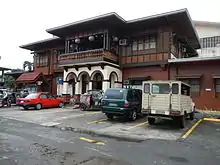
Municipal Officials
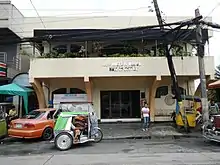
The following are the elected officials of the town elected last May 13, 2019 which serves until 2022:
| Position | Official |
|---|---|
| Mayor | Perfecto V. Fidel (NP) |
| Vice Mayor | Ismael DM. Rodil (NP) |
| Sangguniang Bayan Members | Party |
|---|---|
| Restituto J. Vejerano | NP |
| John Mark M. Cayao | NUP |
| Ferdinand T. Papa | NP |
| Robinson DA. Bernate | NP |
| Virgilo Ll. Rodil | PDPLBN |
| Chrissel R. Borja | Independent |
| Cesar M. Mojica | NP |
| Avegel E. Kasaysayan | NP |
| ABC President | |
| SK Federation President | |
| Kean Ferraer |
Barangay Officials
| Barangay | Barangay Captain | Settlement Type |
|---|---|---|
| Agus-os | Loreto Mojica | Rural |
| Alulod | Kim Joshua Cerdenia | Urban |
| Banaba Cerca | Fermina Rodrin | Rural |
| Banaba Lejos | Lorenzo Sarmiento | Rural |
| Bancod | Ricardo Creencia | Urban |
| Buna Cerca | Romelio Dilig | Rural |
| Buna Lejos I | Marcos Lopez | Rural |
| Buna Lejos II | Raymond James Torres | Rural |
| Calumpang Cerca | Danilo Marero | Rural |
| Calumpang Lejos | Constancio Telmo Jr. | Rural |
| Carasuchi | Eliseo F. Rocela | Rural |
| Daine I | Romulo Patinio | Rural |
| Daine II | Vidal Bergonio Sr. | Rural |
| Guyam Malaki | Vencio Matilla | Rural |
| Guyam Munti | Marcelino Cruzada | Rural |
| Harasan | Danilo Rufin | Rural |
| Kayquit I | Jonathan Lila Jr. | Rural |
| Kayquit II | Roberto Aterrado | Rural |
| Kayquit III | Reynaldo Diesta | Rural |
| Kaytambog | Cesar Sarsiego | Rural |
| Kaytapos | Hernando Mojica | Urban |
| Limbon | Emelita Sarmiento | Rural |
| Lumampong Balagbag | Melencio Bago | Rural |
| Lumampong Halayhay | Arnel Pulido | Rural |
| Mahabang Kahoy Cerca | Ricky Rivera | Rural |
| Mahabang Kahoy Lejos | Moises Pegenia | Rural |
| Mataas na Lupa | Camilo Lontoc | Urban |
| Poblacion I | Isidro Cronico | Urban |
| Poblacion II | Rafael Herrera Jr. | Urban |
| Poblacion III | Avegel Kasaysayan | Urban |
| Poblacion IV | Marcelino Peñaflorida | Urban |
| Pulo | Wilfredo Perido | Rural |
| Tambo Balagbag | Joseph Ilagan | Rural |
| Tambo Ilaya | Margarito Masicap | Rural |
| Tambo Kulit | Antonio Espineli | Rural |
| Tambo Malaki | Cornelio Salazar | Rural |
Demographics
Population
| Year | Pop. | ±% p.a. |
|---|---|---|
| 1903 | 11,526 | — |
| 1918 | 13,232 | +0.92% |
| 1939 | 15,388 | +0.72% |
| 1948 | 15,989 | +0.43% |
| 1960 | 20,268 | +2.00% |
| 1970 | 24,635 | +1.97% |
| 1975 | 28,709 | +3.12% |
| 1980 | 30,977 | +1.53% |
| 1990 | 39,294 | +2.41% |
| 1995 | 42,765 | +1.60% |
| 2000 | 51,281 | +3.97% |
| 2007 | 60,755 | +2.37% |
| 2010 | 62,030 | +0.76% |
| 2015 | 65,599 | +1.07% |
| Source: Philippine Statistics Authority [4] [13] [14][15] | ||
In the 2015 census, the population of Indang, was 65,599 people, [4] with a density of 880 inhabitants per square kilometre or 2,300 inhabitants per square mile. There are five (5) residential subdivisions within the municipality which occupies 44.75 hectares of land.
Languages
The municipality of Indang has a majority of English and Tagalog speakers. Almost all households in the town are bilingual and know how to speak English. [4]
Religion
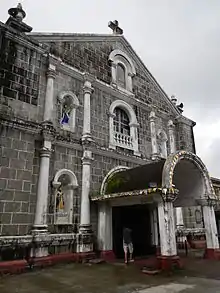
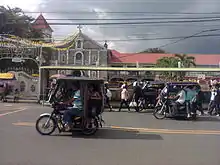
Christianity is the predominant faith, composed of Roman Catholics, Protestants, and other independent Christian groups. A considerable percentage of the population are also composed of Muslims. Religious tolerance exists among members of different sects. [4]
Economy
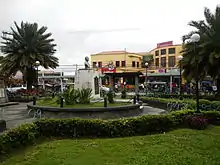
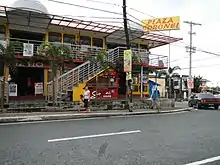
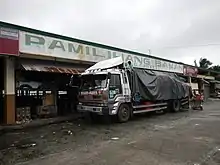
Agriculture
The economy of Indang largely depends on agriculture. It is a first-class municipality. The 80.45% or 7,176.38 hectares are primarily devoted to agriculture. They are predominantly planted with various types of crops like coconut, banana, coffee, fruit trees, and pineapple, while there are small portions of rice, root crops, vegetables, and corn. Most farmers are engaged in multi-cropping farming system. The largest number of employment is farming and trading of agricultural products. Livestock and poultry raisers occupied an area of about 22.76 hectares or 0.32% of the total agricultural area.
Indang has a public market, located in Poblacion 4, where goods such as vegetables, seafood, meat, and household items are sold.
On the trade and industry, existing commercial and agribusiness establishments play a relatively major role in the predominantly agri-based economy of Indang.
Municipal record on this establishment shows the wholesale and retail trade stores are clustered within the poblacion or urban area while in the rural, the trading establishments are dominated by sari-sari stores.
Agro-business commercial farms raise large volumes of livestock and poultry. As per record of the municipal agricultural office, there are existing hog farms, broiler farms, layer and breeder farms.
Indang Public Market and Slaughterhouse stand on 20,316 square metre government-owned property along J. Dimabiling St., Poblacion IV. This public market has three simple market buildings and “Bagsakan” for wholesale trading. The slaughterhouse occupies an area of 1,800 square metres, which is adjacent to meat section of market building. It has complete facilities like corral and hog-holding pen with drainage and sanitation facilities.[16]
Infrastructure
Transportation
.jpg.webp)
Land transportation is the principal mode of transporting goods and services in Indang and its neighbouring municipalities and cities. Vehicular routes going to other municipalities are:
- Indang-Mendez-Tagaytay City via Indang–Mendez Rd., then Mendez–Tagaytay Rd.;
- Indang-Alfonso via Indang–Alfonso Rd.;
- Indang-Naic via Naic–Indang Rd.;
- Indang-Trece Martires City-Dasmariñas City via Trece Martires–Indang Rd. passing to Governor's Drive; and
- Indang-Pasay City (Baclaran) via Trece Martires–Indang Rd., Governor's Drive (Trece Martires City) and Aguinaldo Highway (Dasmariñas City).
There are several types of vehicles traversing the place, but the most commonly used vehicles for public conveyances are busses, jeepneys and a number of tricycles plying within the Poblacion area and nearby barangays.[12]
Indang has 25.57 km barangay roads, 4.982 km municipal roads, 28.64 km provincial roads, 29.64 km national roads, and 46.433 km farm-to-market roads within the municipality. The barangay roads primarily provide the delivery of goods, services, and facilities which bring improvement on the living condition of the rural populace. On the other hand, the 93.10% of farm-to-market roads are not passable particularly during rainy seasons. The widening and improvement of these roads would ensure faster, easier, and safer transport of farm products. There are 30 bridges connecting the 36 barangays of this municipality, these are classified as national, provincial, and barangay bridges.[12][17]
Water
The original waterworks system was constructed in 1922-1924 with Ikloy Spring as its source and covers only the Poblacion. The system consists of a spring chamber, pumphouse with hydro turbine prime over and centrifugal pump, ground reservoir, 2 km transmission pipelines and distribution facilities. In 1980, a separate distribution pipe and ground reservoir in Barangay Kaytambog was included in the system. Total registered concessionaires were 463 as of August 1980. Water production from the spring source is 580 cubic metre of which only 26.6 percent is accounted for. The total water demand for various design years is derived from the demands for domestic, commercial, institutional and public faucets demands including an allowance for leakage and wastage. The possible sources of water supply for Indang are springs, namely, Ikloy, Ipie I and Ipie II. All the springs emanate from fissures on the contact between permeable pyroclastics and impermeable tuff above the river course. The full production of Ikloy Spring alone is estimated to meet the water demand of Indang Water District.[18]
Electricity
The electric services are provided by Meralco, the sole electric power distributor in Indang and Greater Manila Area.
Telecommunication
The Philippine Long Distance Telephone Company (PLDT) and Digital Telecommunications Philippines (Digitel) are the two leading telephone companies serving the municipality. The PLDT has its branch office at barangay Kaytapos, while the Digitel branch office is located at Tagaytay City. Year 2010, Globe Telecom is now operating their telephone lines bundled with DSL to selected barangays of Indang including Poblacion, Kaytapos and Alulod.
Smart Communications, Globe Telecom and Digitel through Sun Cellular installed their Mobile Base Transceiver Stations and Telecommunication Antenna Tower in the locality. Smart has currently five mobile base station towers, Globe has only eight and Sun Cellular has one mobile transceiver facility. Cellular phones are commonly used by the residents especially in remote barangay where telephone landline services are not available.
Newspapers, magazines, and other related reading materials reach the municipality. Likewise, radio and television sets have a good reception. All these forms of communication channels make the populace of Indang well-informed and up-to-date in terms of national and international issues.
Healthcare
M. V. Santiago Medical & Diagnostic Centre is the only hospital in Indang, located in A. Luna St. Poblacion 3, Indang, Cavite and was founded on May 27, 2013.[19]
Education
Cavite State University
_in_Indang%252C_Cavite.jpg.webp)
The Cavite State University, (CvSU) (Filipino: Pamantasang Estado ng Cavite), is a university in the province of Cavite in the Philippines. Its 72-hectare (180-acre) main campus, known as the Don Severino de las Alas Campus, is located in the Municipality of Indang, Cavite about 60 km (37 mi) southwest of Manila. The educational institution has ten other campuses spread all over the province.
The school was established initially as an intermediate school by the Thomasites, a group of American teachers brought by the United States during the early part of the American colonial period to revamp the system of education in the country. By 1964, the school has grown into a college known as the Don Severino Agricultural College (DSAC). It became a university on January 22, 1998, and was renamed as the Cavite State University.
Private Schools
- Holy Family School of Indang Inc.[20]
- Nazarene Christian School of Indang[20]
- Sebastien Montessori, Inc.[20]
- Academia de San Vicente Ferrer[20]
- Hillcrest Periwinkle School, Inc.[20]
- Indang Christian Academy[20]
- Liceo dela Concepcion of Indang[20]
- Lycee de San Antonio Montessori[20]
- Perpetual Cavite Institute[20]
- Royal Palm Academy of Cavite, Inc.[20]
- Saint Gregory Academy[20]
- Daine Western Cavite Institute[20]
Public Elementary Schools
- Agus-os Elementary School[20]
- Alulod Elementary School[20]
- Banaba Cerca Elementary School[20]
- Banaba Lejos Elementary School[20]
- Bancod Elementary School[20]
- Buna Cerca Elementary School[20]
- Buna Lejos Elementary School[20]
- Calumpang Lejos Elementary School[20]
- Carasuchi Elementary School
- Daine Elementary School[20]
- Dr. Alfredo Pio De Roda Elementary School[20]
- Guyam Elementary School[20]
- Guyam Munti Elementary School[20]
- Indang Central Elementary School[20]
- Indang East Elementary School[20]
- Kayquit Elementary School[20]
- Kaytambog Elementary School[20]
- Kaytapos Elementary School[20]
- Lumampong Balagbag Elementary School[20]
- Lumampong Elementary School[20]
- Mahabang Kahoy Cerca Elementary School[20]
- Mahabang Kahoy Lejos Elementary School[20]
- Mataas Na Lupa Elementary School[20]
- Tambo Elementary School[20]
- Tambo Munti-Kulit Elementary School[20]
Sister city
References
- "Municipality of Indang, Cavite – Official Website Of Indang Cavite". indang-cavite.ph. Retrieved 2018-03-10.
- Municipality of Indang | (DILG)
- "Province: Cavite". PSGC Interactive. Quezon City, Philippines: Philippine Statistics Authority. Retrieved 12 November 2016.
- Census of Population (2015). "Region IV-A (Calabarzon)". Total Population by Province, City, Municipality and Barangay. PSA. Retrieved 20 June 2016.
- "PSA releases the 2015 Municipal and City Level Poverty Estimates". Quezon City, Philippines. Retrieved 1 January 2020.
- "Municipality of Indang | Cavite". cavite.gov.ph. Retrieved 2017-11-10.
- "Profile – Municipality of Indang, Cavite". indang-cavite.ph. Retrieved 2018-01-13.
- User, Super. "Indang". calabarzon.dilg.gov.ph. Retrieved 2017-10-22.
- "Cavite town mayor, 2 others dismissed for allowing water project". Rappler. Retrieved 2017-11-25.
- "Tagaytay tourism taking water away from Cavite residents?". Rappler. Retrieved 2018-03-21.
- "Indang: Average Temperatures and Rainfall". Meteoblue. Retrieved 12 May 2020.
- "Google Maps". Google Maps. Retrieved 2017-10-22.
- Census of Population and Housing (2010). "Region IV-A (Calabarzon)". Total Population by Province, City, Municipality and Barangay. NSO. Retrieved 29 June 2016.
- Censuses of Population (1903–2007). "Region IV-A (Calabarzon)". Table 1. Population Enumerated in Various Censuses by Province/Highly Urbanized City: 1903 to 2007. NSO.
- "Province of Cavite". Municipality Population Data. Local Water Utilities Administration Research Division. Retrieved 17 December 2016.
- "Business Profile – Municipality of Indang, Cavite". indang-cavite.ph. Retrieved 2018-01-13.
- "Profile – Municipality of Indang, Cavite". indang-cavite.ph. Retrieved 2018-02-16.
- "About Us". indangwd.com. Retrieved 2017-12-01.
- "M. V. Santiago Medical & Diagnostic Center - Indang". www.facebook.com. Retrieved 2017-12-01.
- "DepEd Calabarzon". Department of Education. October 22, 2017.
- "Mayor Pecto invited for an official visit at Gangneung City, South Korea – Municipality of Indang, Cavite". indang-cavite.ph. Retrieved 2017-11-24.
External links
| Wikimedia Commons has media related to Indang, Cavite. |
